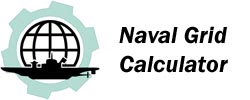|
|
|
| |
|
|
| |
|
|
| |
Navigation: |
|
| |
The primary method of navigation aboard U-boats was by sextant.
Position was calculated and plotted in degrees, minutes and tenths of minutes of
latitude and longitude. In order to transmit positions efficiently
and reliably over the radio, the Kriegsmarine used a system of grid squares.
The Kriegsmarine used a map of the world's oceans laid out in squares
with the first two characters (BC 1857 for example) identifying
the large square and the next 4 characters (BC 1857 for example)
identifying the position within that square. When all six characters
were given, a typical grid square was 6 x 6 nm. See the links below
for an explanation of this system. Only first two characters were
given when referring to just the large square and zeros were substituted
for the numbers if a less specific position was intended. In radio
messages the grids were often reported in coded form by using a pre-defined
offset and /or encoding the letters and numbers with reference to a code
book (Adressbuch) carried for that purpose. |
|
| |
|
|
| |
Click the icon to explore and practice German WWII era celestial navigation |
|
| |
 |
|
Download the F-Tafel (the German sight reduction procedure), 1941 Nautisches Jahrbuch (German Nautical Almanac), sight reduction forms and view translations with notes |
|
|
| |
|
|
| |
|
|
| |
Click the icon to proceed to pages describing the Kriegsmarine grid system |
|
| |
 |
|
Explanation of the Kriegsmarine
grid system at Uboat.net |
 |
|
Kriegsmarine Quadrant converter by Jan Kockrow |
|
|
| |
|
|
| |
Some commanders used unofficial additions to the grids to write down their position more precisely. These were written as various abbreviations from one to three letters behind the six characters of the Naval grid system to give the exact position within the small square. The combinations used were put together from these six abbreviations:
|
|
| |
Abbreviation |
German |
English |
|
rechts |
right |
|
links |
left |
|
mitte |
center |
|
oben |
upper |
|
unten |
lower |
|
Kante |
edge |
|
Ecke |
corner |
|
|
| |
For example, “l.o.E.” means left upper corner and “r.K.m.” is the middle of the right edge. The image below shows where these positions were located within a grid square. |
|
| |
|
|
| |
In addition to the abbreviations above, sometimes the CO might refer to the edge of a square using the abbreviations, l.K., r.K., o.K. or u.K. The order of the letters in the abbreviations is variable so l.o. might appear as o.l or r.K.m. might appear as m.r.K. (except as noted below). For the purpose of translating the following convention will be adopted. |
|
| |
| Abbreviation |
Translation |
|
Abbreviation |
Translation |
| |
|
|
|
|
| r. |
right half |
|
l.K. |
left edge |
| l. |
left half |
|
r.K |
right edge |
| o. |
upper half |
|
o.K. |
upper edge |
| u. |
lower half |
|
u.K. |
lower edge |
| |
|
|
|
|
| m. |
center |
|
l.K.m |
center-left edge |
| l.m. |
center-left |
|
r.K.m |
center-right edge |
| r.m. |
center-right |
|
o.K.m. |
upper-center edge |
| |
|
|
u.K.m. |
lower-center edge |
| l.o. |
upper-left |
|
|
|
| m.o. |
upper-center |
|
l.o.m. |
upper-left center |
| r.o. |
upper-right |
|
r.u.m. |
lower-right center |
| |
|
|
l.u.m |
lower-left center |
| u.l |
lower-left |
|
r.o.m. |
upper-right center |
| u.m |
lower-center |
|
|
|
| u.r. |
lower-right |
|
Note: the order of the initials in the group below may not be altered without changing the position witin the grid square |
| l.o.E. |
upper-left corner |
|
l.K.o. |
left edge upper |
| r.o.E. |
upper-right corner |
|
o.K.l. |
upper edge left |
| l.u.E |
lower-left corner |
|
o.K.r. |
upper edge right |
| r.u.E. |
lower-right corner |
|
r.K.o. |
right edge upper |
| |
|
|
r.K.u. |
right edge lower |
| |
|
|
u.K.r. |
lower edge right |
| |
|
|
u.K.l. |
lower edge left |
| |
|
|
l.K.u. |
left edge lower |
|
|
| |
|
|
| |
|
|
 |
 |
 |